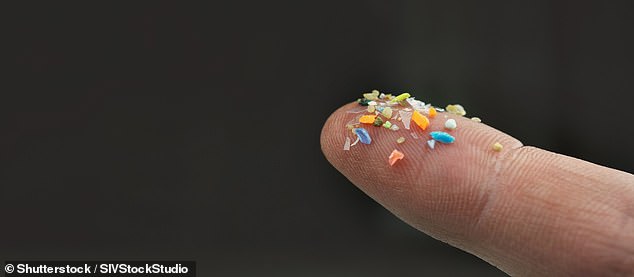When it comes to sources of microplastics, water bottles, plastic bags, or even clothing fibers might spring to mind.
But scientists now say that another source deserves more attention.
According to researchers from the University of Toronto, paint has been ‘severely understudied’ when it comes to research on microplastics.
This is particularly problematic given how ubiquitous paint is, according to the experts.
‘There’s paint from boats. There’s also paint on buildings, on our roads,’ said Dr Zoie Diana, co-author of the study.
‘Once you walk around the city, you start to see it everywhere you look.’
Microplastics are plastic fragments that measure less than 5mm in diameter and are invisible to the naked eye.
Worryingly, previous studies have linked the tiny fragments with toxic impacts on the body, such as cancer.

When it comes to sources of microplastics, water bottles, plastic bags, or even clothing fibers might spring to mind. But scientists now say that another source deserves more attention
Microplastics have been found almost everywhere on Earth, ranging from the peak of Mount Everest to the depths of the Marianna Trench.
They’re known to accumulate in air, water, food, and even our bodies over time.
Worryingly, they have been shown to have toxic effects on not only human health, but also marine life.
In their new study, the team set out to understand whether or not researchers should be focusing on microplastics from paint.
As we all know, paints are used across a huge variety of indoor and outdoor applications, ranging from road markings to ships.
‘A recent estimate that accounts for more sources of paints from the architectural, marine, road markings, industrial, automotive, and industrial wood sectors projects that 1,857 kt of paint microplastics are emitted into the global environment annually,’ the researchers explained in their study, published in Environmental Toxicology and Chemistry.
‘[This] would make paint a large source, if not the largest source, of microplastics to the environment.’
Paints release microplastics in various different ways, according to the team.

As we all know, paints are used across a huge range of indoor and outdoor applications, ranging from road markings to ships
‘When paint on a surface fragments into particles less than 5mm in size, microplastics are formed,’ they said.
‘Paint fragmentation may occur during maintenance/repairs (e.g., scraping, sanding, stripping, sand-blasting), application, use, disposal, and environmental weathering.’
In the latest study, the researchers analysed the previous studies on microplastics from paint, and uncovered a ‘significant research gap’.
‘We identified just 62 articles published on paint microplastics over the last two decades,’ the team said.
The researchers suggest that the gap may come down to confusion regarding whether paint contains plastic.
‘Estimates suggest that paints are 37% plastic on average,’ the researchers said.
Based on the findings, the researchers are calling for urgent research on the impact of microplastics from paint.
‘Baseline research is needed to better understand the sources of paint microplastics, identification methods, environmental concentrations, and toxicological effects on organisms and populations,’ they concluded.
‘The suggested baseline research builds upon the studies identified in our literature review and will provide information that can be used to strengthen our scientific understanding of microplastics and, in the future, be used to inform policy and management.’
This article was originally published by a www.dailymail.co.uk . Read the Original article here. .


